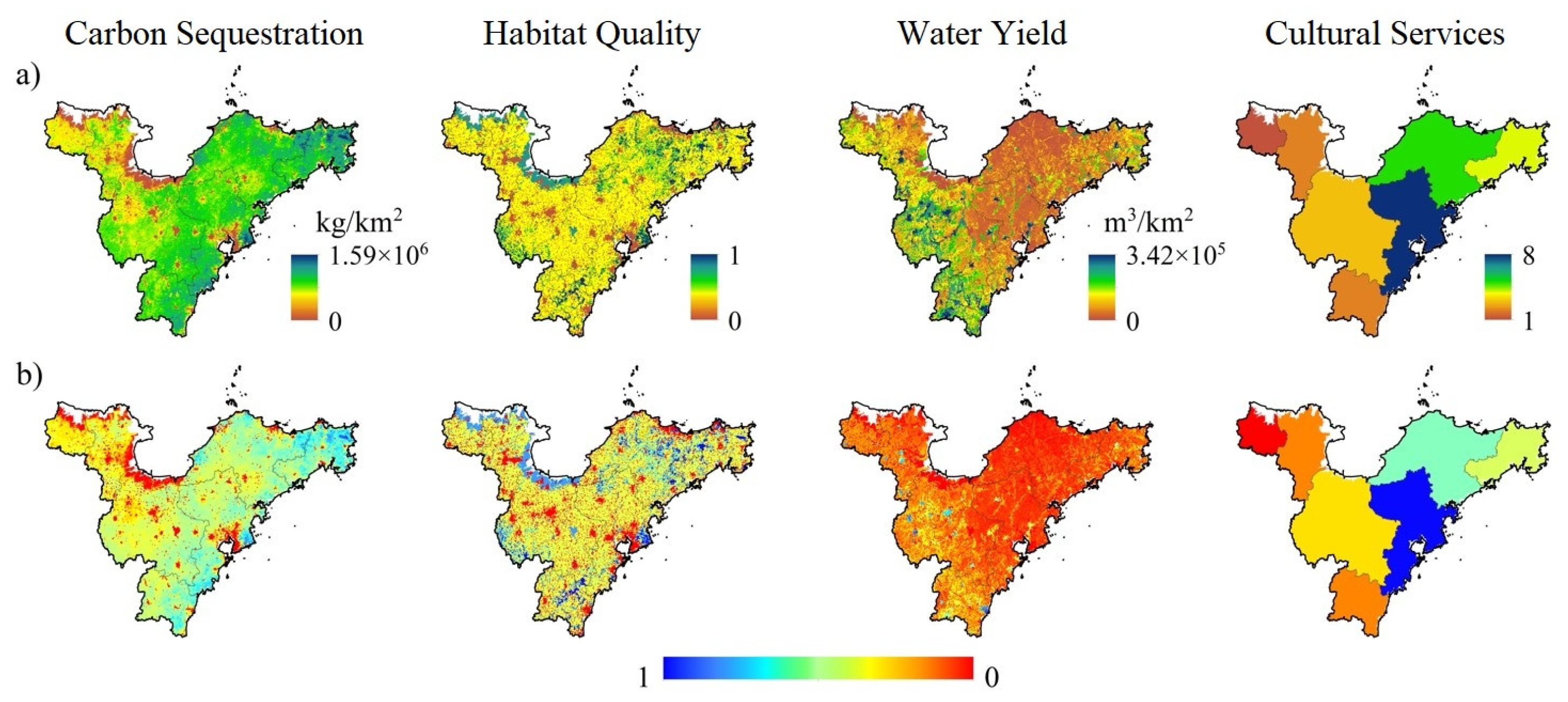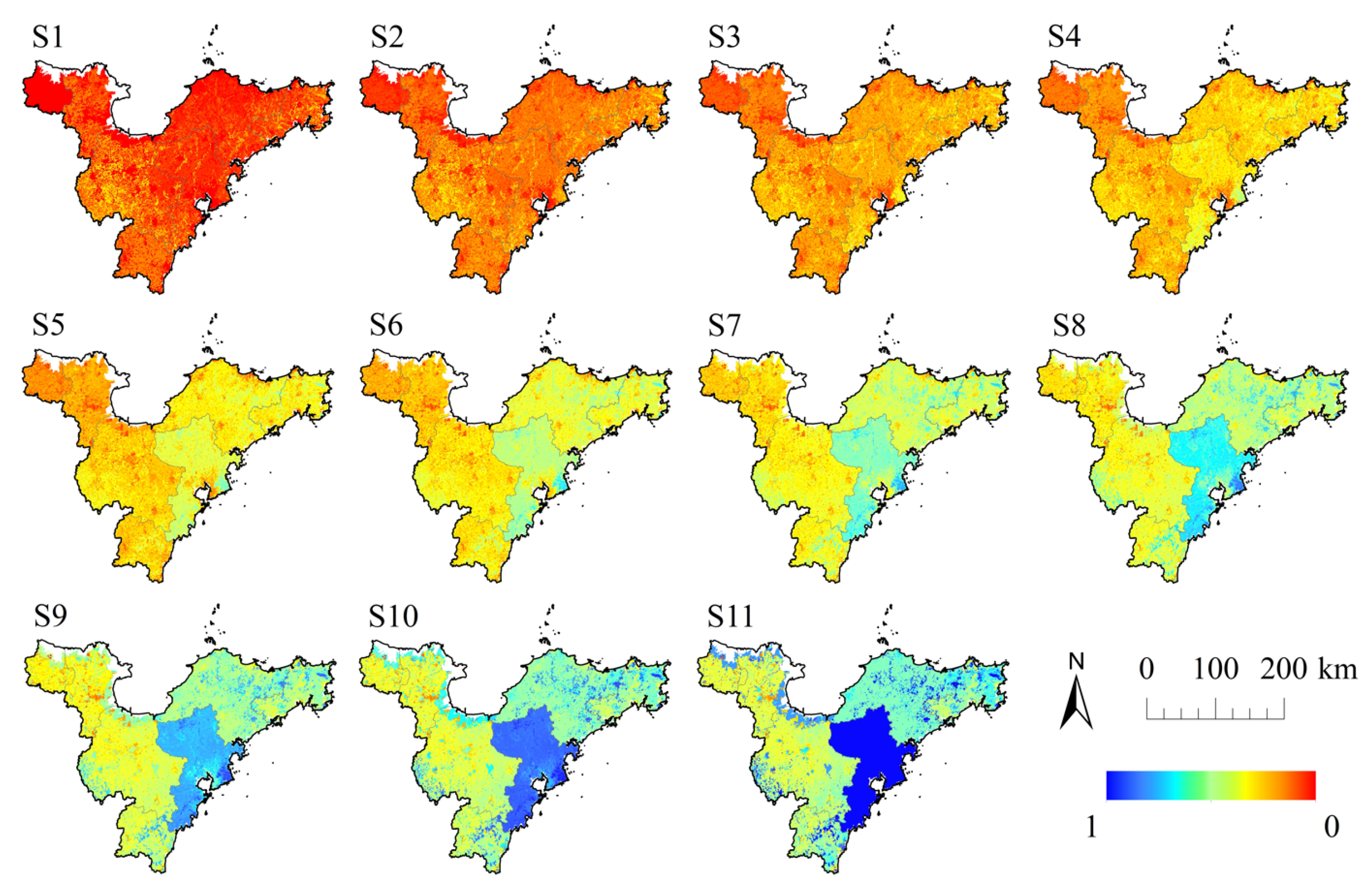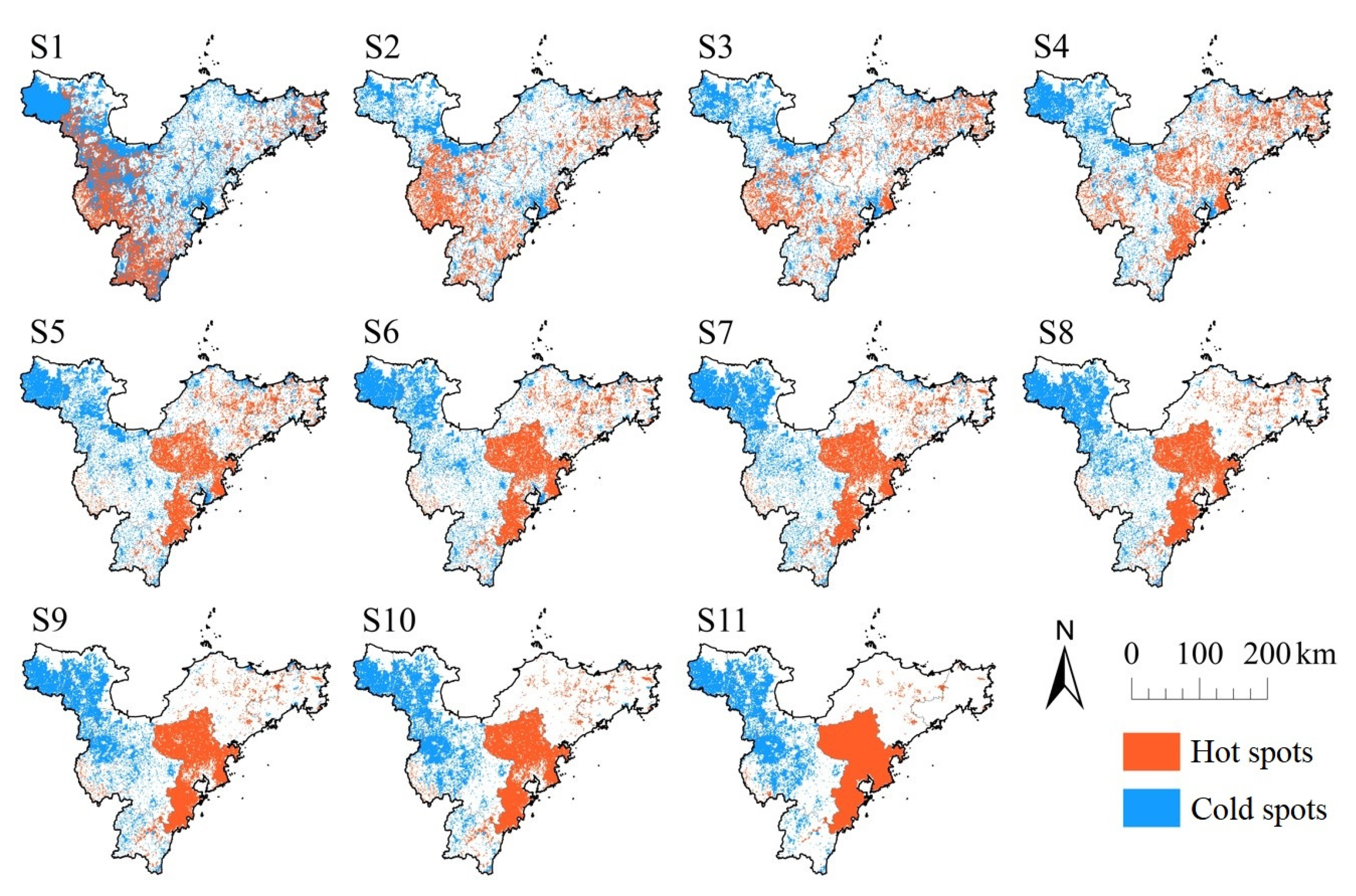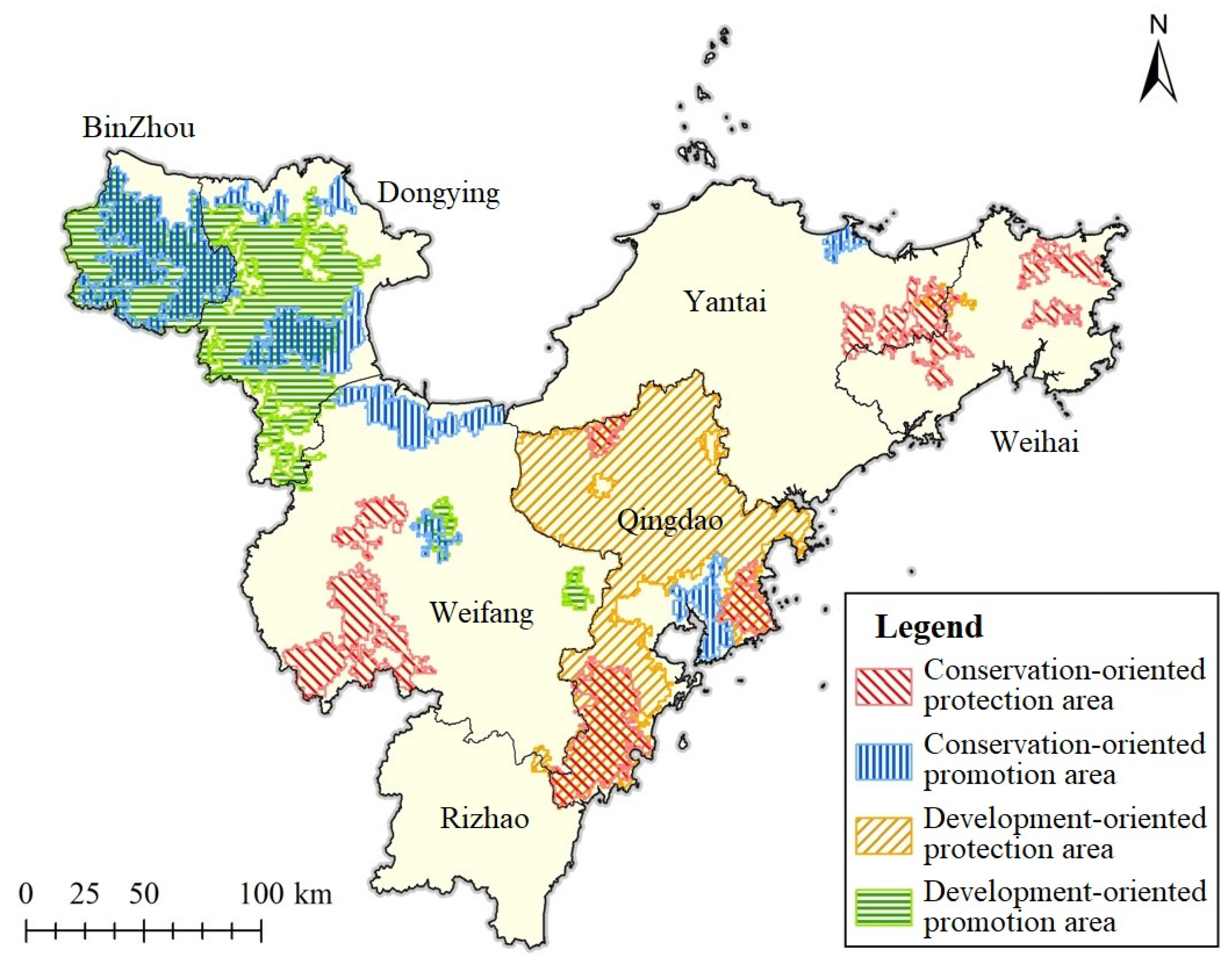Multi-Criteria Decision-Making Scenario Insights into Spatial Responses and Promotion Under Ecosystem Services
Abstract
1. Introduction
2. Materials and Methods
2.1. Study Area
2.2. Methods
2.2.1. Ecosystem Services Assessment
2.2.2. Multi-Scenario Analysis Based on Ordered Weighted Averaging
- (1)
- Ordered weight averaging
- (2)
- Risk and Trade-Offs
- (3)
- Different policy scenarios
2.2.3. Hotspot/Cold Spot Region Identification
2.2.4. Protection Efficiency Quantification
3. Results
3.1. Multiple Ecosystem Services Assessment
3.2. Spatial Patterns of Ecosystem Services Under Multiple Policy Scenarios
3.3. Identification of Cold Spot and Hotspot Regions Under Each Scenario
3.4. Ecosystem Service Efficiency Assessment
3.5. Spatial Pattern Optimization
4. Discussion
5. Conclusions
Supplementary Materials
Author Contributions
Funding
Data Availability Statement
Conflicts of Interest
Abbreviations
| MA | Millennium Ecosystem Assessment |
| OWA | Ordered weighted average |
| DEM | Digital elevation model |
| NPP | Net primary productivity |
| CASA | Carnegie–Ames–Stanford approach |
| APAR | Absorbed photosynthetically active radiation |
| InVEST | Integrated Valuation of Ecosystem Services and Trade-offs |
| SolVES | Social Values for Ecosystem Services |
| GIS | Geographic information system |
References
- Bukhard, B.; Kroll, F.; Nedkov, S.; Müller, F. Mapping ecosystem services supply, demand and budgets. Ecol. Indic. 2012, 21, 17–29. [Google Scholar] [CrossRef]
- Metzger, J.P.; Villarreal-Rosas, J.; Suárez-Castro, A.F.; López-Cubillos, S.; González-Chaves, A.; Runting, R.K.; Hohlenwerger, C.; Rhodes, J.R. Considering landscape-level processes in ecosystem service assessments. Sci. Total Environ. 2021, 796, 149028. [Google Scholar] [CrossRef] [PubMed]
- The Millennium Ecosystem Assessment. Millennium Ecosystem Assessment: Ecosystems and Human Well-Being; World Resources Institute: Washington, DC, USA, 2005. [Google Scholar]
- Costanza, R. Ecosystem services: Multiple classification systems are needed. Biol. Conserv. 2008, 141, 350–352. [Google Scholar] [CrossRef]
- Xie, G.; Liu, J.; Xu, J.; Xiao, Y.; Zhen, L.; Zhang, C.; Wang, Y.; Qin, K.; Gan, S.; Jiang, Y. A spatio-temporal delineation of trans-boundary ecosystem service flows from Inner Mongolia. Environ. Res. Lett. 2019, 14, 065002. [Google Scholar] [CrossRef]
- Liu, J.; Qin, K.; Xie, G.; Xiao, Y.; Huang, M.; Gan, S. Is the ‘water tower’reassuring? Viewing water security of Qinghai-Tibet Plateau from the perspective of ecosystem services ‘supply-flow-demand’. Environ. Res. Lett. 2022, 17, 094043. [Google Scholar] [CrossRef]
- Liu, J.; Qin, K.; Zhen, L.; Xiao, Y.; Xie, G. How to allocate interbasin water resources? A method based on water flow in water-deficient areas. Environ. Dev. 2020, 34, 100460. [Google Scholar] [CrossRef]
- Mandle, L.; Shields-Estrada, A.; Chaplin-Kramer, R.; Mitchell, M.G.E.; Bremer, L.L.; Gourevitch, J.D.; Hawthorne, P.; Johnson, J.A.; Robinson, B.E.; Smith, J.R.; et al. Increasing decision relevance of ecosystem service science. Nat. Sustain. 2021, 4, 161–169. [Google Scholar] [CrossRef]
- Liu, J.; Qin, K.; Xie, G. The effects and influencing variables based on “supply-direction-demand” flow processing: Water provisioning services of Inner Mongolia’s ecological shelters. Land Degrad. Dev. 2024, 35, 3490–3505. [Google Scholar] [CrossRef]
- Loomes, R.; O’Neill, K. Nature’s Services: Societal Dependence on Natural Ecosystems. Pac. Conserv. Biol. 1997, 6, 220–221. [Google Scholar] [CrossRef]
- Gómez-Baggethun, E.; Barton, D.N. Classifying and valuing ecosystem services for urban planning. Ecol. Econ. 2013, 86, 235–245. [Google Scholar] [CrossRef]
- Liu, J.; Li, J.; Qin, K.; Zhou, Z.; Yang, X.; Li, T. Changes in land-uses and ecosystem services under multi-scenarios simulation. Sci. Total Environ. 2017, 586, 522–526. [Google Scholar] [CrossRef] [PubMed]
- Hou, Y.; Lü, Y.; Chen, W.; Fu, B. Temporal variation and spatial scale dependency of ecosystem service interactions: A case study on the central Loess Plateau of China. Landsc. Ecol. 2017, 32, 1201–1217. [Google Scholar] [CrossRef]
- Thomas, C.D.; Anderson, B.J.; Moilanen, A.; Eigenbrod, F.; Heinemeyer, A.; Quaife, T.; Roy, D.B.; Gillings, S.; Armsworth, P.R.; Gaston, K.J. Reconciling biodiversity and carbon conservation. Ecol. Lett. 2012, 16, 39–47. [Google Scholar] [CrossRef] [PubMed]
- Rodríguez, N.; Armenteras, D.; Retana, J. National ecosystems services priorities for planning carbon and water resource man-agement in Colombia. Land Use Policy 2015, 42, 609–618. [Google Scholar] [CrossRef]
- Qin, K.; Li, J.; Yang, X. Trade-Off and Synergy among Ecosystem Services in the Guanzhong-Tianshui Economic Region of China. Int. J. Environ. Res. Public Health 2015, 12, 14094–14113. [Google Scholar] [CrossRef]
- Barrena, J.; Nahuelhual, L.; Báez, A.; Schiappacasse, I.; Cerda, C. Valuing cultural ecosystem services: Agricultural heritage in Chiloe island, southern Chile. Ecosyst. Serv. 2014, 2014, 66–75. [Google Scholar] [CrossRef]
- Malinga, R.; Gordon, L.J.; Jewitt, G.; Lindborg, R. Mapping ecosystem services across scales and continents—A review. Ecosyst. Serv. 2015, 13, 57–63. [Google Scholar] [CrossRef]
- Lyu, R.; Clarke, K.C.; Zhang, J.; Feng, J.; Jia, X.; Li, J. Dynamics of spatial relationships among ecosystem services and their determinants: Implications for land use system reform in Northwestern China. Land Use Policy 2021, 102, 105231. [Google Scholar] [CrossRef]
- Iniesta-Arandia, I.; García-Llorente, M.; Aguilera, P.A.; Montes, C.; Martín-López, B. Socio-cultural valuation of ecosystem services: Uncovering the links between values, drivers of change, and human well-being. Ecol. Econ. 2014, 108, 36–48. [Google Scholar] [CrossRef]
- Pleasant, M.M.; Gray, S.A.; Lepczyk, C.; Fernandes, A.; Hunter, N.; Ford, D. Managing cultural ecosystem services. Ecosyst. Serv. 2014, 8, 141–147. [Google Scholar] [CrossRef]
- Sherrouse, B.C.; Semmens, D.J.; Clement, J.M. An application of Social Values for Ecosystem Services (SolVES) to three national forests in Colorado and Wyoming. Ecol. Indic. 2014, 36, 68–79. [Google Scholar] [CrossRef]
- Zhao, Y.; Wang, M.; Lan, T.; Xu, Z.; Wu, J.; Liu, Q.; Peng, J. Distinguishing the effects of land use policies on ecosystem services and their trade-offs based on multi-scenario simulations. Appl. Geogr. 2023, 151, 102864. [Google Scholar] [CrossRef]
- Ding, X.; Jian, S. Synergies and trade-offs of ecosystem services affected by land use structures of small watershed in the Loess Plateau. J. Environ. Manag. 2024, 350, 119589. [Google Scholar] [CrossRef] [PubMed]
- Feng, Q.; Zhao, W.; Hu, X.; Liu, Y.; Daryanto, S.; Cherubini, F. Trading-off ecosystem services for better ecological restoration: A case study in the Loess Plateau of China. J. Clean. Prod. 2020, 257, 120469. [Google Scholar] [CrossRef]
- Qin, K.; Li, J.; Liu, J.; Yan, L.; Huang, H. Setting conservation priorities based on ecosystem services—A case study of the Guanzhong-Tianshui Economic Region. Sci. Total Environ. 2019, 650, 3062–3074. [Google Scholar] [CrossRef] [PubMed]
- Pan, J.; Wei, S.; Li, Z. Spatiotemporal pattern of trade-offs and synergistic relationships among multiple ecosystem services in an arid inland river basin in NW China. Ecol. Indic. 2020, 114, 106345. [Google Scholar] [CrossRef]
- Yohannes, H.; Soromessa, T.; Argaw, M.; Dewan, A. Impact of landscape pattern changes on hydrological ecosystem services in the Beressa watershed of the Blue Nile Basin in Ethiopia. Sci. Total. Environ. 2021, 793, 148559. [Google Scholar] [CrossRef] [PubMed]
- Syrbe, R.-U.; Walz, U. Spatial indicators for the assessment of ecosystem services: Providing, benefiting and connecting areas and landscape metrics. Ecol. Indic. 2012, 21, 80–88. [Google Scholar] [CrossRef]
- Yan, X.; Huang, M.; Tang, Y.; Guo, Q.; Wu, X.; Zhang, G. Study on the Dynamic Change of Land Use in Megacities and Its Impact on Ecosystem Services and Modeling Prediction. Sustainability 2024, 16, 5364. [Google Scholar] [CrossRef]
- Jiang, W.; Gao, G.; Wu, X.; Lv, Y. Assessing Temporal Trade-Offs of Ecosystem Services by Production Possibility Frontiers. Remote Sens. 2023, 15, 749. [Google Scholar] [CrossRef]
- Luo, Y.; Guo, X.; Lü, Y.; Zhang, L.; Li, T. Combining spatiotemporal interactions of ecosystem services with land patterns and processes can benefit sensible land-scape management in dryland regions. Sci. Total Environ. 2024, 909, 168485. [Google Scholar] [CrossRef] [PubMed]
- Peng, L.; Chen, T.; Deng, W.; Liu, Y. Exploring ecosystem services trade-offs using the Bayesian belief network model for ecological restoration decision-making: A case study in Guizhou Province, China. Ecol. Indic. 2022, 135, 108569. [Google Scholar] [CrossRef]
- Myers, N. Threatened biotas: “Hot spots” in tropical forests. Environmentalist 1988, 8, 187–208. [Google Scholar] [CrossRef] [PubMed]
- Gos, P.; Lavorel, S. Stakeholders’ expectations on ecosystem services affect the assessment of ecosystem services hotspots and their congruence with biodiversity. Ecosyst. People 2012, 8, 93–106. [Google Scholar] [CrossRef]
- Spanò, M.; Leronni, V.; Lafortezza, R.; Gentile, F. Are ecosystem service hotspots located in protected areas? Results from a study in Southern Italy. Environ. Sci. Policy 2017, 73, 52–60. [Google Scholar] [CrossRef]
- Schröter, M.; Remme, R.P. Spatial prioritisation for conserving ecosystem services: Comparing hotspots with heuristic optimisation. Landsc. Ecol. 2016, 31, 431–450. [Google Scholar] [CrossRef]
- Zhou, G.; Huan, Y.; Wang, L.; Zhang, R.; Liang, T.; Zhang, C.; Wang, S. Identifying synergies and hotspots of ecosystem services for the conservation priorities in the Asian Water Tower region. Reg. Environ. Chang. 2023, 23, 1–12. [Google Scholar] [CrossRef]
- Schröter, M.; Kraemer, R.; Ceauşu, S.; Rusch, G.M. Incorporating threat in hotspots and coldspots of biodiversity and ecosystem services. Ambio 2017, 46, 756–768. [Google Scholar] [CrossRef]
- Yager, R. On ordered weighted averaging aggregation operators in multicriteria decision making. IEEE Trans. Syst. Man Cybern. 1988, 18, 183–190. [Google Scholar] [CrossRef]
- Li, H.; Ma, Z.; Zhu, Y.; Liu, Y.; Yang, X. Planning and prioritizing forest landscape restoration within megacities using the ordered weighted averaging operator. Ecol. Indic. 2020, 116, 106499. [Google Scholar] [CrossRef]
- Malczewski, J.; Chapman, T.; Flegel, C.; Walters, D.; Shrubsole, D.; Healy, M.A. GIS—Multicriteria Evaluation with Ordered Weighted Averaging (OWA): Case Study of Developing Watershed Management Strategies. Environ. Plan. A Econ. Space 2003, 35, 1769–1784. [Google Scholar] [CrossRef]
- Kiker, G.A.; Bridges, T.S.; Varghese, A.; Seager, T.P.; Linkov, I. Application of multicriteria decision analysis in environmental decision making. Integr. Environ. Assess. Manag. 2005, 1, 95–108. [Google Scholar] [CrossRef] [PubMed]
- Tsonkova, P.; Quinkenstein, A.; Böhm, C.; Freese, D.; Schaller, E. Ecosystem services assessment tool for agroforestry (ESAT-A): An approach to assess selected ecosystem services provided by alley cropping systems. Ecol. Indic. 2014, 45, 285–299. [Google Scholar] [CrossRef]
- Wang, J.; Xing, Y.; Chang, X.; Yang, H.; Yang, C.; Xue, G.; Li, C. Identification of priority conservation areas for Natural Forest Protection Project in Northeastern China based on OWA-GIS. Ecol. Indic. 2024, 160, 111718. [Google Scholar] [CrossRef]






| Service Types | Water Yield (mm) | Carbon Sequestration (kg/km2) | Biodiversity (Dimensionless) | Aesthetics and Scientific Research (Dimensionless) | Data Sources |
|---|---|---|---|---|---|
| Remote sensing imagery | ○ | ○ | Landsat 8 | ||
| DEM | ○ | ○ | Shuttle Radar Topography Mission | ||
| Land use | ○ | ○ | Resources and Environmental Science Data Center | ||
| Soil type | ○ | World Soil Database | |||
| Evapotranspiration | ○ | ○ | China Meteorological Data Service Centre | ||
| Temperature | ○ | China Meteorological Data Service Centre | |||
| Precipitation | ○ | China Meteorological Data Service Centre | |||
| Solar radiation | ○ | China Meteorological Data Service Centre | |||
| Slope | ○ | DEM extraction | |||
| Mountain shading | ○ | DEM extraction | |||
| Distance to rivers | ○ | Buffer analysis | |||
| Distance to water bodies | ○ | Buffer analysis | |||
| Cognitive level | ○ | Questionnaire survey | |||
| Calculation method | InVEST | CASA | InVEST | SolVES |
| Protection ← | Neutral | → Development | |||||||||
|---|---|---|---|---|---|---|---|---|---|---|---|
| Decision scenario | S1 | S2 | S3 | S4 | S5 | S6 | S7 | S8 | S9 | S10 | S11 |
| Risk level | 0 | 0.1 | 0.2 | 0.3 | 0.4 | 0.5 | 0.6 | 0.7 | 0.8 | 0.9 | 1 |
| w1 | 0 | 0.01 | 0.05 | 0.1 | 0.17 | 0.25 | 0.35 | 0.46 | 0.6 | 0.76 | 1 |
| w2 | 0 | 0.04 | 0.11 | 0.17 | 0.21 | 0.25 | 0.27 | 0.28 | 0.25 | 0.18 | 0 |
| w3 | 0 | 0.18 | 0.25 | 0.28 | 0.27 | 0.25 | 0.21 | 0.17 | 0.11 | 0.04 | 0 |
| w4 | 1 | 0.76 | 0.6 | 0.46 | 0.35 | 0.25 | 0.17 | 0.1 | 0.05 | 0.01 | 0 |
| ω Trade-off level | 0 | 0.37 | 0.57 | 0.71 | 0.86 | 1 | 0.86 | 0.71 | 0.57 | 0.37 | 0 |
| Service | Water Yield | Carbon Sequestration | Biodiversity | Aesthetics and Scientific Research | Average | |||||
|---|---|---|---|---|---|---|---|---|---|---|
| Scenario | Cold Spot | Hotspot | Cold Spot | Hotspot | Cold Spot | Hotspot | Cold Spot | Hotspot | Cold Spot | Hotspot |
| S1 | 0.89 | 2.02 | 0.71 | 1.09 | 0.67 | 1.14 | 0.90 | 0.78 | 0.79 | 1.26 |
| S2 | 0.76 | 1.97 | 0.53 | 1.14 | 0.55 | 1.23 | 0.88 | 0.97 | 0.68 | 1.33 |
| S3 | 0.82 | 1.70 | 0.54 | 1.21 | 0.58 | 1.35 | 0.76 | 1.15 | 0.67 | 1.35 |
| S4 | 0.87 | 1.31 | 0.56 | 1.26 | 0.60 | 1.41 | 0.67 | 1.39 | 0.68 | 1.34 |
| S5 | 0.92 | 0.86 | 0.56 | 1.27 | 0.61 | 1.43 | 0.63 | 1.61 | 0.68 | 1.29 |
| S6 | 0.98 | 0.75 | 0.61 | 1.25 | 0.57 | 1.43 | 0.59 | 1.66 | 0.69 | 1.27 |
| S7 | 1.02 | 0.72 | 0.68 | 1.24 | 0.58 | 1.41 | 0.54 | 1.69 | 0.71 | 1.27 |
| S8 | 1.07 | 0.73 | 0.70 | 1.23 | 0.59 | 1.36 | 0.54 | 1.72 | 0.72 | 1.26 |
| S9 | 1.12 | 0.73 | 0.70 | 1.20 | 0.63 | 1.27 | 0.54 | 1.75 | 0.75 | 1.24 |
| S10 | 1.24 | 0.72 | 0.72 | 1.20 | 0.70 | 1.26 | 0.54 | 1.76 | 0.80 | 1.24 |
| S11 | 1.27 | 0.66 | 0.72 | 1.09 | 0.75 | 1.03 | 0.54 | 1.87 | 0.82 | 1.16 |
Disclaimer/Publisher’s Note: The statements, opinions and data contained in all publications are solely those of the individual author(s) and contributor(s) and not of MDPI and/or the editor(s). MDPI and/or the editor(s) disclaim responsibility for any injury to people or property resulting from any ideas, methods, instructions or products referred to in the content. |
© 2024 by the authors. Licensee MDPI, Basel, Switzerland. This article is an open access article distributed under the terms and conditions of the Creative Commons Attribution (CC BY) license (https://creativecommons.org/licenses/by/4.0/).
Share and Cite
Liu, J.; Qin, K.; Xiao, Y.; Xie, G. Multi-Criteria Decision-Making Scenario Insights into Spatial Responses and Promotion Under Ecosystem Services. Land 2024, 13, 1964. https://doi.org/10.3390/land13111964
Liu J, Qin K, Xiao Y, Xie G. Multi-Criteria Decision-Making Scenario Insights into Spatial Responses and Promotion Under Ecosystem Services. Land. 2024; 13(11):1964. https://doi.org/10.3390/land13111964
Chicago/Turabian StyleLiu, Jingya, Keyu Qin, Yu Xiao, and Gaodi Xie. 2024. "Multi-Criteria Decision-Making Scenario Insights into Spatial Responses and Promotion Under Ecosystem Services" Land 13, no. 11: 1964. https://doi.org/10.3390/land13111964
APA StyleLiu, J., Qin, K., Xiao, Y., & Xie, G. (2024). Multi-Criteria Decision-Making Scenario Insights into Spatial Responses and Promotion Under Ecosystem Services. Land, 13(11), 1964. https://doi.org/10.3390/land13111964





